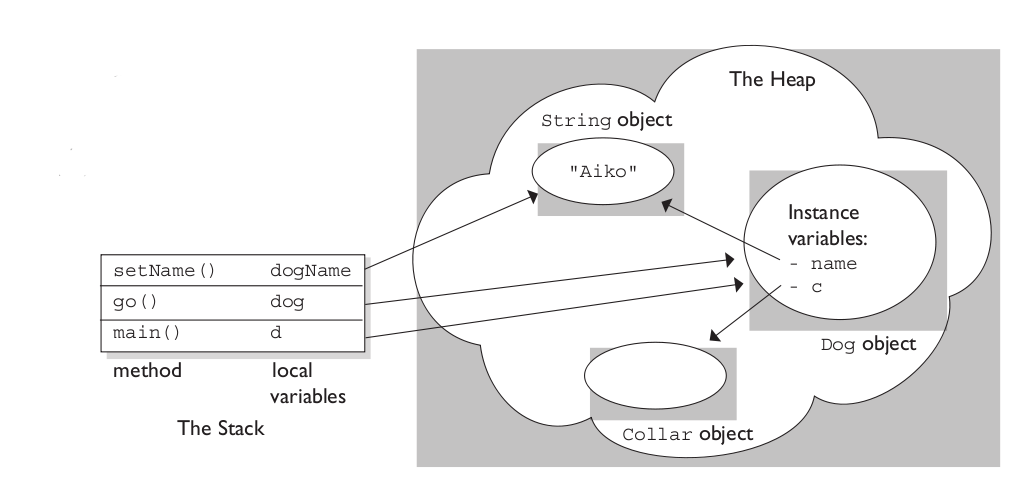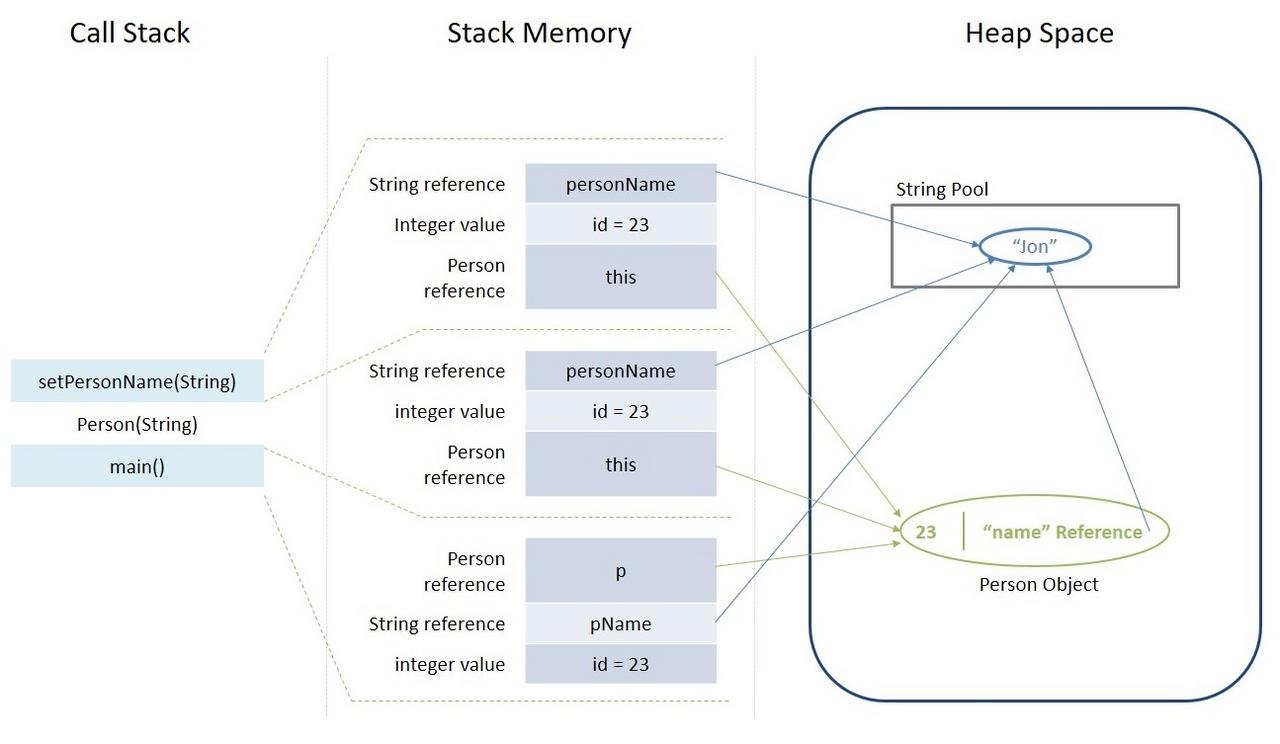Java - Memory Allocation 內存分配
Where storage lives
-
Registers
This is the fastest storage because it exists in a place different from that of other storage: inside the central processing unit (CPU). However, the number of registers is severely limited, so registers are allocated as they are needed. You don’t have direct control over register allocation, nor do you see any evidence in your programs that registers even exist (C & C++, on the other hand, allow you to suggest register allocation to the compiler) -
The stack
This lives in the general random-access memory (RAM) area, but has direct support from the processor via its stack pointer. The stack pointer is moved down to create new memory and moved up to release that memory. This is an extremely fast and efficient way to allocate storage, second only to registers. The Java system must know, while it is creating the program, the exact lifetime of all the items stored on the stack. This constraint places limits on the flexibility of your programs, so themselves are not placed on the stack. -
The heap
This is a general-purpose pool of memory (also in the RAM area) where all Java objects live. Unlike the stack, the compiler doesn’t need to know how long objects must stay on the heap. Thus, there’s a great deal of flexibility when using heap storage. Whenever you need an object, you write the code to create it using new, and the storage is allocated on the heap when that code is executed. There’s a price for this flexibility: It can take more time to allocate and clean up heap storage than stack storage (if you even could create objects on the stack in Java, as you can in C++). Over time, however, Java’s heap allocation mechanism has become very fast, so this is not an issue for concern. -
Constant storage
Constant values are often placed directly in the program code, which is safe since they can never change. Sometimes constants are cordoned off by themselves so they can be optionally placed in read-only memory (ROM), in embedded systems. -
Non-RAM storage
If data lives completely outside a program, it can exist while the program is not running, outside the control of the program. The two primary examples of this area serialized object, where objects are turned into streams of bytes, generally send to another machine, and persistent objects, where the objects are placed on disk so they will hold their state even when the program is terminated. The trick with there types of storage is turning the objects into something that exist on the other medium, and yet be resurrected into a regular RAM-based object when necessary. Java provides support for lightweight persistence. Libraries such as JDBC and Hibernate provide more sophisticated support for storing and retrieving object information using databases.
- Thinking in Java 4th edition page 42
Stack vs Heap
my summary:
| Stack memory | Heap space | |
|---|---|---|
| storage | local variables and function call | instance variables and objects |
| static or dymatic | static memory | dynamic memory |
| memory error | java.lang.StackOverFlowError | java.lang.OutOfMemoryError |
| threads | stack is kind of private memroy of Java Threads (threadsafe) | heap memory is shared among all threads (not threadsafe) |
baeldung summary:
| Parameter | Stack memory | Heap Space |
|---|---|---|
| Application | Stack in used in parts, one at a time during execution of a thread | THe entire application uses Heap space during runtime |
| Size | Stack has size limits depending upon OS and is usually smaller then Heap | THere is no size limit on Heap |
| Storage | Stores only primitive variables and references to objects that are created in Heap Space | All the newly created objects are stored here |
| Order | It is accessed using Last-in First-out (LIFO) memory allocation system | This memory is accessed via complex memory management techniques that include Young Generation, Old Generation or Tenured Generation, and Permanent Generation. |
| Life | Stack memory only exists as long as the current methods is running | Heap space exists as long as the application runs |
| Efficiency | Comparatively much faster to allocate when compared to heap | Slower to allocate when compared to stack |
| Allocation/ Deallocation |
This Memory is automatically allocated and deallocated when a method is called and returned respectively | Heap space is allocated when new objects are created and deallocated by Garbage Collector when they are on longer referenced |
Memory allocation in Java
init object
In Java, all objects are dynamically allocated on Heap. This is different from C++ where objects can be allocated memory either on Stack or on Heap.
In C++, when we allocate the object using new(), the object is allocated on Heap, otherwise on Stack if not global or static.
In Java, when we only declare a variable of a class type, only a reference is created (memory is not allocated for the object). To allocate memory to an object, we must
use new(). So the object is always allocated memory on heap.
(See this for more details.)
For example, following program fails in the compilation. Compiler gives error Error here because i is not initialized.
public class Main {
public static void main(String[] args) {
Test t;
// Error here because t is not initialzed
t.show();
}
}
Allocating memory using new() makes above program work.
public class Main {
public static void main(String[] args) {
// all objects are dynamically allocated
Test t = new Test();
t.show(); // no error
}
}
invoke method
- Instance variables and Objects lie on Heap
Remember this is where the state is maintained and when you get memory leaks this is where your profiler helps you to find the allocation of memory.
- Local variables and methods lie on the Stack
So if we have a main method which calls the go() method which calls the gone() method then the stack from top to bottom would consist of:
gone()
go()
main()
as soon as gone() has been processed, it would be removed from the stack. Any corresponding local variables which are used in gone() would also would also be removed from the stack.
Stack would have references to objects on the Heap.

memory managed
Let’s analyze a simple Java code and let’s assess how memory is managed here:
class Person {
int pid;
String name;
// constructor, setters/getters
}
public class Driver {
public static vodi main(String[] args) {
int id = 23;
String pName = "Jon";
Person p = null;
p = new Person(id, pName);
}
}
Let’s analyze this step by step:
- Upon entering the
main()method, a space in stack memory would be created to store primitives and references of this method- The primitive value of integer
idwill be stored directly in stack memory - The reference variable
pof typePersonwill also be created in stack memory which will point to the actual object in the heap
- The primitive value of integer
- The call to the parameterized constructor
Person(int, String)frommain()will allocate further memory on top of the previous Stack. This will store:- The
thisobject reference of the calling object in stack memory - The primitive value
idin the stack memory - The reference variable of
StringargumentpersonNamewhich will point to the actual string from string pool in heap memory (See string in memory)
- The
- This default constructor is further calling
setPersonName()method, for which further allocation will take place in stack memory on top of previous one. This will again store variables in the manner described above. - However, for the newly created object
pof typePerson, all instance variables will be stored in heap memory.
This allocation is explained in this diagram:

Reference
more resource: